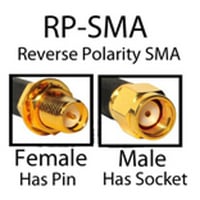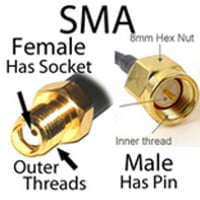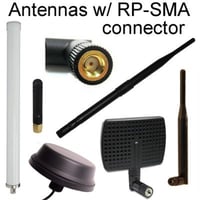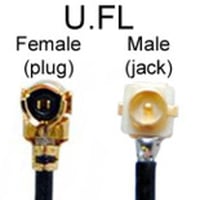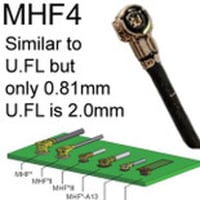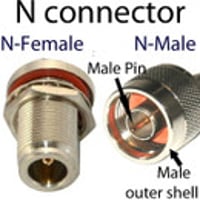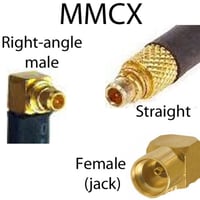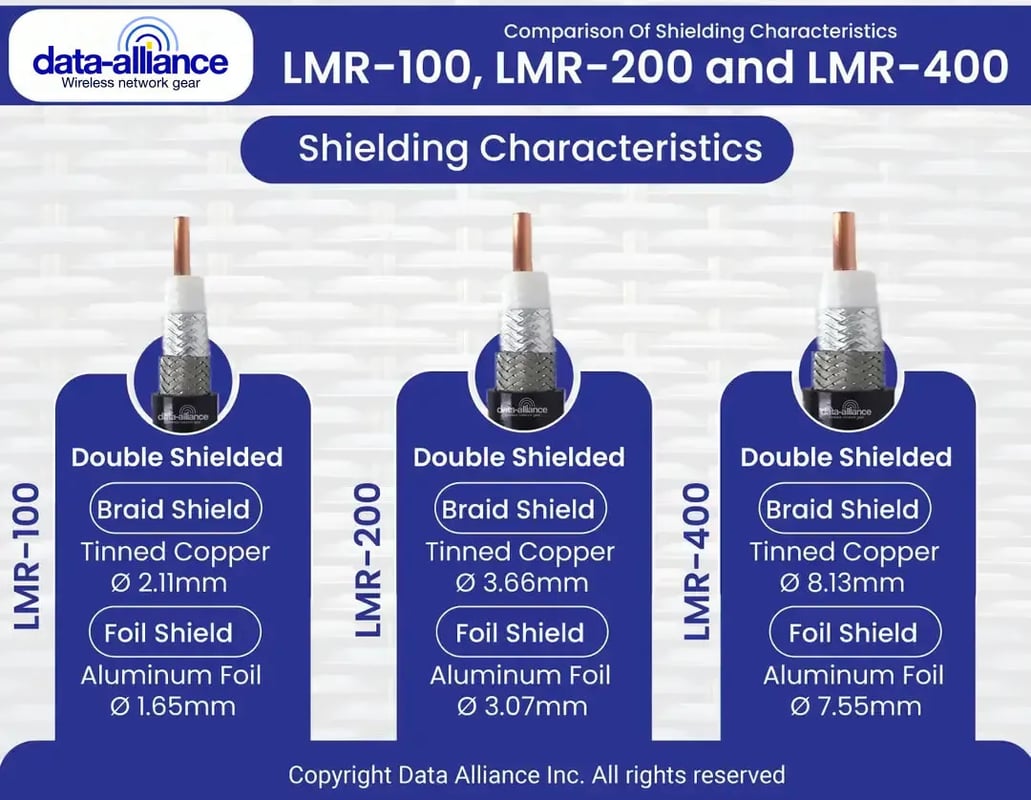RP-SMA Extension Cable: 12FT 15FT 17FT 20FT 22FT 25FT 30FT 35FT 40FT 50FT Low Loss
- SKU:
- RSm12ftRSf200
- Availability:
- In stock
- Weight:
- 1.00 LBS
Data Alliance
RP-SMA Male to Female Cables 12FT to 50FT
- One end has an RP-SMA female connector, and the other has an RP-SMA male connector.
- We understand that different setups require different cable lengths. That's why we offer a range of options, from a compact six meters (20 feet) to a generous 50 feet, allowing you to choose the perfect fit for your application.
- See other lengths of this RP-SMA extension cable.
- Data Alliance's high-quality soldered terminations of RP-SMA connectors with soldering provide a low-loss connection with discontinuities kept to a minimum.
- Former Part # E8 is now RSm25ftRSf200
See also: Directory of other RP-SMA cable types. RP SMA Dimensions
We offer two options for the thickness of the cable (both are double-shielded, with a black jacket): LMR-400 and LMR-200:
- Our 400-series coaxial cable type, equivalent to LMR-400, offers significantly lower attenuation (signal loss) than the 200-series. These cables feature nickel-plated brass connectors, the most corrosion-resistant plating available for antenna cable connectors, making them ideal for outdoor and indoor use.
- 200-series coaxial ca ble-type (equivalent to LMR-200) has much lower attenuation (signal loss) than LMR-100 and RG58. All the cables on this page that are 200-series coax have gold-plated brass connectors.
- In both cases of coax types, the cables are rated for outdoor use and suitable for indoor use.
- The double-shielding of both 200-series and 400-series cables enables low signal loss. Both are flexible and easily bendable (the 200-series is more flexible and bendable). Double-shielding is a significant factor in the higher quality of this cable, which translates into lower loss and better performance.
The temperature range for operational use of these 200-series and 400-series cable assemblies is as follows: -31 F ~ +203 F (-35 C ~ +95 C)
Special versions:
- We have a 25-FT version with an elongated threaded section of the RP-SMA-female connector (14.5mm threaded section). The part number for this is RSm25ftRSfL200 (To order this, contact Customer Service). Our standard 25-ft version is part# RSm25ftRSf200 (which can be ordered on this web page).
- We can produce any length or version with the more extended threaded section of the RP-SMA-female connector (as a particular order): Contact Customer Service.

Compatibility with wireless standards & applications:
Versatile RP-SMA extension cable Support:
Covering frequencies from 0GHz to 18GHz and providing low VSWR and 50 Ohm impedance, these cables offer exceptional compatibility for:
- WiFi bands: Full support for 2.4GHz and 8GHz, including Wi-Fi HaLow (802.11AH), 802.11AX, 802.11AC, 802.11N, 802.11G, 802.11B, and 802.11A.
- Cellular networks: Including LTE / 4G, GSM / 3G, and WiMax
- IoT & M2M solutions: Bluetooth, ZigBee, WiFi HaLow, RFID, LoRa, LTE-m, NB-IoT, WiFi 6, WiFi 6E.
- Helium Mining in North America: Compatible with Bobcat, Sensecap, and all Helium LongFi miners—as are all our RP-SMA-male connector-equipped antenna cables and adapters.
RoHS 3 and REACH compliant: Our antenna cables and RF adapters comply with RoHS 3 and REACH restrictions on lead content and other heavy metals and toxins.
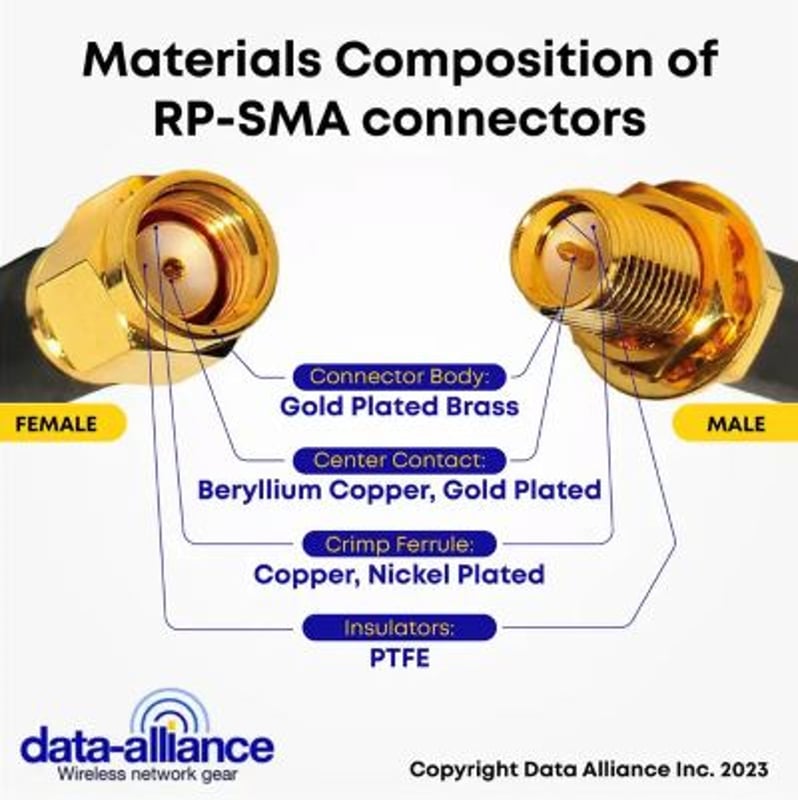
Coaxial Cable Types for Long RP-SMA Extension Cables: LMR-200 and LMR-400
LMR-200 and LMR-400 are low-loss coaxial cables manufactured simply for transmitting radio frequency signals in antenna cables. They are suited to many practical industrial uses, including Wi-Fi, Bluetooth, and broadband internet networks.
Before we delve into the details of the product, let's define what a low-loss coaxial cable is. The composition of a typical coaxial cable is as such:
- Copper clad-steel conductor - low impedance and high tensile strength conducting wire
- Dielectric PE foam - relatively minimal absorption of electrical charge
- Double shielding - both aluminum foil and braided copper for the blocking out of any environmental signal disturbance
- Outer Jacket—UV stable and flame retardant protective casing ideal for indoor and outdoor environments from the day of installation for years to come.
The following is a simple head-to-head comparison between LMR-400 and LMR-200 low-loss RF coaxial cables:
Composition
1. Inner conductor
- LMR-200 conductor: under 1.42 mm in diameter
- LMR-400 conductor: above 2.74 mm in diameter
2. Dielectric foam diameter & material
- LMR-200 foam diameter: 3.81 mm, Polyethylene foam
- LMR-400 cable sheath: 7.24, Polyethylene foam
3. Inner shield
- LMR-200 inner shield: tinned copper braiding
- LMR-400 inner shield: (same as above)
4. Outer shield
- LMR-200 outer shield: aluminum foil
- LMR-400 outer shield: (same as above)
5. Outer cable sheath diameter, material & color
- LMR-200 cable sheath: under 6.1 mm in diameter, Polyethylene, black
- LMR-400 cable sheath: above 10.29 mm in diameter, Thermoplastic elastomer, black
Some other associated physical characteristics of LMR-200 vs LMR-400
Temperature stability = both max. Eighty-five degrees C / min. -40 degrees C, they are suitable for work in extremely hot or cold environments. Bending radius = a single bend of LMR-200 and LMR-400 have radii of over 19 mm and under 25 mm, respectively. The double bend is over 63 mm for LMR-200 and below 102 mm. Weight = the LMR-200, at 0.06 kg/m, is just under half as heavy per m as LMR-400, at 0.102 kg/m. Neither cable needs a trailing cable nor contains halogen in its material makeup.
Attenuation
The following data quantifies the estimated loss of signal strength typically attributed to the LMR-200 and LMR-400:
At 900 MHz
- LMR-200 = 0.09 dB/ft.
- LMR-400 = 0.039 dB/ft.
At 2400 MHz
- LMR-200 = 0.12 dB/ft.
- LMR-400 = 0.066 dB/ft.
At 3500 MHz
- LMR-200 = 0.21 dB/ft.
- LMR-400 = 0.081 db/ft.
At 5800 MHz
- LMR-200 = 0.264 dB/ft.
- LMR-400 = 0.108 dB/ft.
Double shielding benefits
Both cables are double-shielded, with aluminum foil (100%) and copper braiding (70%+), for maximum signal protection from EMI/noise. This combination of shielding methods provides maximum noise attenuation and interference annulment.
RP SMA Connector Key Information, including dimensions and materials composition
RP-SMA Gender Determination: Key Points
- RP-SMA gender is counter-intuitive.
- The gender refers to the pins inside the threads. RP-SMA male has threads on the inside.
- RP-SMA (reverse polarity) means that the pin and socket configuration is the opposite of what you would expect: RP-SMA female has a pin inside, and RP-SMA male has a socket inside.
- More details regarding SMA & RP-SMA gender determination.
PRODUCTS RELATED:
Frequently Asked Questions
What are the insertion loss characteristics of these RP-SMA extension cables over different lengths?
Insertion loss varies with length. For instance, a 12-foot cable may exhibit approximately 0.9 dB loss, while a 50-foot cable can have up to 3.8 dB loss. The exact loss depends on the frequency of operation, with higher frequencies generally experiencing greater loss.
How does the cable shielding effectiveness impact signal integrity in high-interference environments?
These cables feature double shielding with a combination of foil and braid, providing over 90 dB of shielding effectiveness. This high level of shielding minimizes electromagnetic interference, maintaining signal integrity even in environments with significant RF noise.
What are the specific materials used in the cable's construction, and how do they affect performance?
The cable core is made of a high-purity copper conductor, which ensures minimal signal attenuation. The dielectric is often made from PTFE, providing excellent insulation properties and high-temperature resistance. The outer jacket is typically UV-resistant PVC, suitable for outdoor use.
What is the maximum power rating for these RP-SMA extension cables, and how does it vary with frequency?
The power rating of these cables typically ranges up to 50 watts at lower frequencies (up to 3 GHz). At higher frequencies, the maximum power rating decreases due to increased insertion loss and potential heating effects.
What are the return loss specifications for these cables, and why is this important?
Return loss indicates how much signal is reflected back towards the source, affecting overall system performance. These cables typically have a return loss of better than 20 dB up to 3 GHz, ensuring minimal reflections and maintaining signal quality.
How does the use of RP-SMA connectors affect the overall performance of the extension cables?
RP-SMA connectors are known for their reliability and low insertion loss. The precision design ensures consistent performance and minimal signal loss at the connector interface, which is crucial for maintaining overall cable performance.
Can these cables be used in high-vibration environments, and what design features support this?
Yes, these cables can be used in high-vibration environments. The robust construction, including reinforced connectors and strain reliefs, helps prevent signal degradation and physical damage in such conditions.
How do these cables perform in terms of signal propagation delay, and what applications are sensitive to this parameter?
Signal propagation delay is minimal but increases with length. For instance, a 12-foot cable has a delay of approximately 12 nanoseconds. Applications like high-frequency trading, precision GPS, and real-time communication systems are particularly sensitive to propagation delays.

